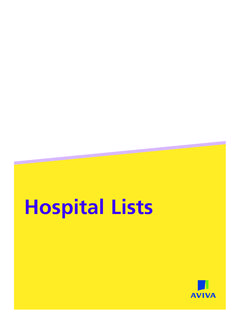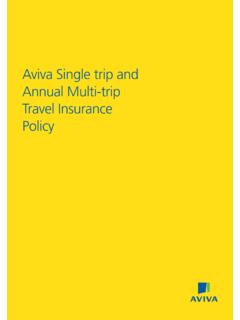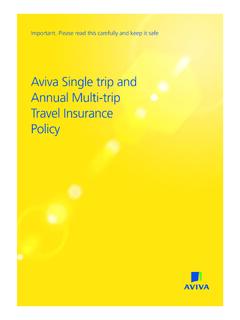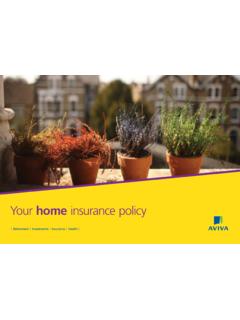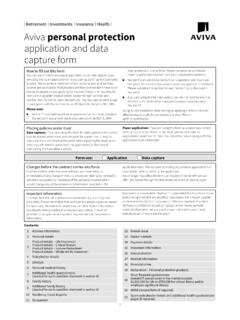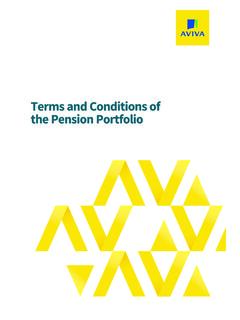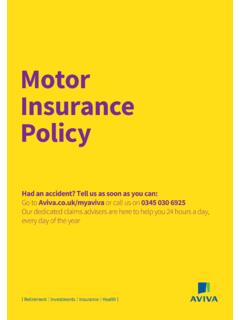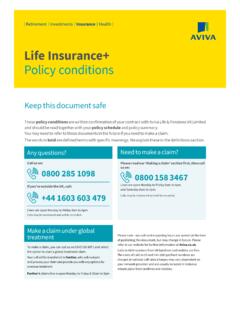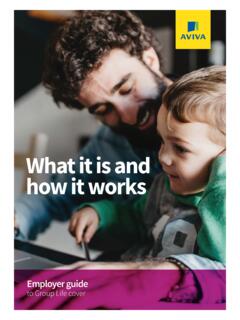Transcription of Protection occupation guide - aviva.co.uk
1 Protection occupation guideOccupation class guide for use with: Income Protection +, Living Costs ProtectionTotal permanent disability & waiver of premium guide for: Life Insurance+, Critical Illness+, Business Life Insurance Options and Relevant Life InsuranceFor financial adviser use only. Not approved for use with 117/07/2020 11:002 Protection occupation GuideIntroductionTo make the underwriting process easier for you and your client, we ve developed this guide to explain: how we determine the risk of an occupation how we assess an occupation what our occupation classes are what our definition of incapacity is what happens if your client isn t working when they re incapacitated how much benefit your client will get how we calculate your client s normal ve also included a list of occupation classifications which you can use to make sure the illustration you give your client reflects their occupation you need more information about our income Protection policies, please read the relevant policy conditions we determine the risk of an occupationIt s important that our underwriters understand the nature of your client s occupational duties.
2 Whilst the occupation classification list provides you with a good starting point, there can be other risks specific to your client s job that we ll need to take into we need to know: if your client performs any manual duties as part of their occupation and whether they need any special skills if your client works at heights, underground, offshore, at sea or underwater if your client works with hazardous chemicals, explosives or machinery if your client s occupation involves overseas business travel your client s annual business for coverAs long as your client is working in one of the occupations we cover, it doesn t matter if they are employed or self-employed, or they work full or part-time. We ll still consider their application for income Protection . If your client is applying for Income Protection + we won t place any restriction on the number of hours your client works each week if they re part time.
3 However, if your client is applying for Living Costs Protection they need to be working at least 16 hours a we assess an occupation : Business mileage if your client drives more than 25,000 business miles a year, their occupation class will be at least Class 2. If they drive more than 40,000 miles a year, it will be at least Class 3. Doctors and surgeons if your client is a doctor, their occupation class will be Class 1. If they are a surgeon or psychiatrist, it will be Class 2. Dual occupations if your client works in two occupations, they need to be unable to perform both before they can make a claim. If your client is unable to perform only one of their occupations when they make a claim then we may be able to make a partial payment of benefit. Our underwriters will consider the risk of both occupations when they assess the occupation classification. If your client does an occupation that forms less than 10 hours of their average working week, this will be ignored at the point of claim for determining incapacity for Income Protection +.
4 Overseas travel if your client s occupation involves overseas travel, we may need to increase the occupation class. We ll take the type of occupation , duration, purpose of visits and countries visited into account. When assessing travel outside of the EU, North America, Australia or New Zealand, we ll also take the travel recommendations of the Foreign & Commonwealth Office into consideration. Oil and gas workers we ll only cover your client if they work in the oil and gas industry within the EU, North America, Australia or New is one of the risks we assess as part of our underwriting process when your client applies for Protection . The price your client pays for income Protection will depend on their occupation . occupation will also determine acceptability for total permanent disability (TPD) and waiver of premium for Life Insurance+, Critical Illness+, Business Life Insurance Options, and Relevant Life Insurance (TPD only).
5 It also determines the definition of disability at the point of to our underwritersWe ve tried to give you the information you need to understand our underwriting process. However, we can t cover every scenario in this guide . So if you re not sure how we ll assess your client s occupation , please call our underwriters on 0800 533 217/07/2020 11 3 ResidencyAt the time of completing the application the person covered must meet our residency criteria, which is:'To apply for this policy the person covered must:1. be currently physically living in the UK, the Channel Islands, the Isle of Man or Gibraltar; and2. regard the UK, the Channel Islands, the Isle of Man or Gibraltar as the location of their main residence; and have no current intention of moving outside of any of those territories permanently; and3. eithera. be a citizen of that territory or a British Overseas Territories citizen, orb.
6 Have been granted permission to settle permanently in the named territory, orc. be applying for a mortgage on a residential property which is, or will be, their main residence in that person covered needs to tell us if they move outside of the UK, the Channel Islands, Isle of Man or Gibraltar, and their main residence is in another territory. We may need to change, reduce or remove any of their policy terms. We ll give the person covered details once they ve told us. The person covered should seek their own independent advice if they wish to continue with their policy after they move to another classificationsTo help us determine the risk of an occupation , we use four classifications:Class 1 Professional, executive, managerial, clerical, administrative, office duties. No/little travel involved as part of the 2 Skilled occupations involving a moderate degree of manual duties and semi-skilled occupations that involve a limited degree of manual duties.
7 Travel may be a feature of the 3 Skilled occupations involving mostly manual duties and semi-skilled occupations that involve a moderate degree of manual 4 Semi-skilled occupations where duties are mostly manual and some unskilled occupations where the hazards are may apply some restrictions to occupations. For example, the maximum age for anyone working in an occupation in classes 3 or 4 is 65. And the minimum deferred period for all occupations in class 4 is 13 are a number of occupations where we consider the risk to be too great for us to offer income Protection of incapacityWe want your clients to understand how we ll assess their inability to work in the event of a claim. So we just use an own occupation definition of incapacity:We ll pay the income Protection benefit if the person covered by the policy was working in a full or part-time occupation immediately before the start of the incapacity, and, as a result of the incapacity, they are: unable to perform the activities or tasks of their occupation either on a full or part-time basis; and are not working in any other occupation .
8 occupation means a trade, profession or type of work undertaken for profit or reward. It isn t a specific job with any particular employer and is independent of happens if my client isn t working when they are incapacitated?We won t be able to provide cover if your client isn t working or is a house person when they apply for income , we know that things may change after your client has taken out a policy so there maybe a period of time when they aren t working. For example, they may be raising a family or caring for a sick relative. Or they may be made redundant or decide to take a career Protection +If this happens and your client isn t working or is a house person immediately before they are incapacitated, we ll assess them on an own occupation definition for the job they were doing before they stopped they become ill or have an injury within three months of being made redundant, or are on maternity, parental or adoption leave (up to 52 weeks from the child s date of birth or legal adoption), we will treat their claim as if they were still there is an extended period where the customer is not working then restricted benefit will be paid.
9 This means we will pay benefit for a maximum of 12 months. Your client will not be able to make a further claim on the policy until they have returned to work for at least six consecutive Costs ProtectionIf you client becomes ill or has an injury whilst they are on maternity, parental or adoption leave (up to 52 weeks from the child s date of birth or legal adoption) they can claim benefit. We ll assess them on an own occupation definition for the job they were doing before they stopped ll pay benefit for a maximum of 12 months. Your client will not be able to make a further claim on the policy until they have returned to work for at least six consecutive 317/07/2020 11:004 Protection occupation GuideIf your client is unemployed or working less than 16 hours a week immediately before they become ill or have an injury they will be unable to claim on the much benefit will my client get?
10 Income Protection + onlyWe ll pay 65% of the first 60,000 of their gross earnings, and 45% of any gross earnings above 60,000 up to a maximum benefit amount of 240,000* a year ( 20,000 a month).If your client gets any income from other sources, we ll take it off the amount we ll from other sources includes: continuing income from a business or employer net of any tax income from a pension which is first paid after incapacity other insurance benefits paid due to incapacity that either make payments to your client or make regular payments on their behalf, such as mortgage payment Protection , loan or credit card Protection , pension premium protector.* If your client chooses to increase their benefit each year through the increasing cover option the amount we pay can exceed the maximum of 240,000 ( 20,000 a month).Living Costs Protection onlyIf your client has a Living Costs Protection they can choose a monthly benefit of between 500 and 1,500.
